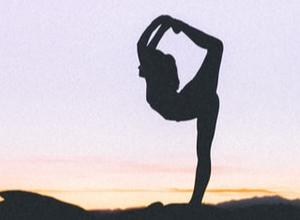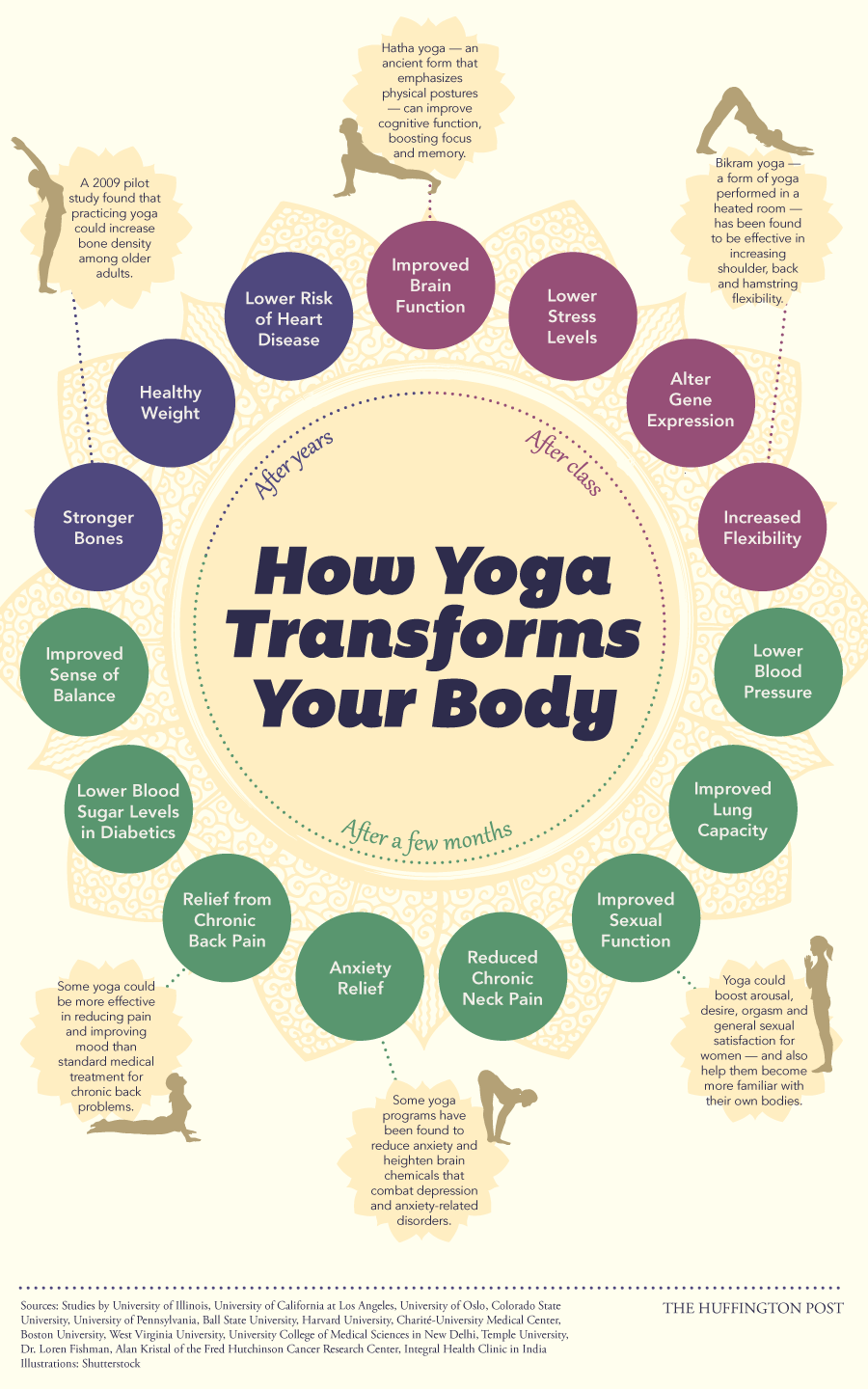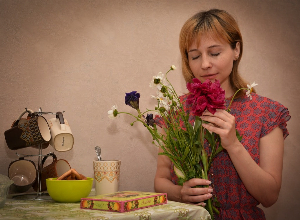How can yoga improve the lives of patients with chronic illness?
Published Aug 4, 2020 • By Candice Salomé
Far from being a purely spiritual discipline, yoga brings many benefits both physiologically and psychologically. But is it a sport suitable for patients with chronic illnesses? What are the real benefits of yoga? Is it a discipline suitable for everyone?

Yoga: countless benefits for mental and physical health
Yoga is an ancestral mind-body practice originating in India which has become more and more present in the western world. Yoga is often presented as a method to better manage stress and anxiety, but it has many other health benefits.
There are many different styles of yoga which consist mainly of meditation and breathing exercises combined with various physical exercises. The goal of yoga practice is to increase physical, mental, emotional and spiritual well-being.

Source: The Huffington Post
While yoga has many benefits, it is also recommended for many chronic conditions:
For cardiovascular conditions:
The benefits of exercise on overall health and on cardiovascular health in particular are well known. But not everyone has the physical ability to engage in sustained activity such as jogging, cycling or tennis, for example.
Yoga is a gentle, low-intensity activity that does not cause shortness of breath and focuses on breathing, concentration and flexibility.
For diabetes:
According to a Reuters study, yoga is beneficial for diabetics because the movements and poses allow the pancreas to produce more insulin. Thus, the blood sugar ratio can be lowered. However, one should continue to take a walk every day.
For asthma:
Hatha yoga* is perfect for asthma patients. It allows to slow one's breathing rhythm while also increasing breathing amplitude. As a result, asthmatics can increase their breathing capacity with certain targeted exercises.
*This type of yoga, through the precise and paced practice of poses, allows the practitioner to control the body and the senses.
For fibromyalgia:
A Canadian study, published in the Journal of Pain Research, demonstrated the beneficial effects of yoga on fibromyalgia. The study found that yoga can impact cortisol levels in patients (cortisol secretion is often disrupted in women with fibromyalgia), a hormone that, when lower than normal, contributes to pain, fatigue and stress.
The study showed that after a 75-minute hatha yoga session, participants' saliva showed improved cortisol levels. Patients also reported a significant decrease in pain, as well as psychological well-being related to the physical practice.
For cancer and chronic pain:
Yoga is now often offered in some hospitals or clinics for patients with cancer and/or chronic pain.
Yoga can be a good alternative to drug treatments to alleviate pain. It also allows patients to re-appropriate and reconnect with their bodies, which have often been battered by treatments, after cancer.
For sleep disorders:
Nidra yoga* has an extremely relaxing effect and helps to relieve both physical and mental stress. It teaches how to relax all one's muscles to more easily enter into the sleep phase.
*Nidra yoga is often called "sleep yoga". It is most often practiced while lying on the ground in the "Savasana" pose. The teacher guides the student towards meditation and relaxation exercises that are done mentally.
For depression, anxiety and stress:
"Yoga can be a remedy on its own for depression, especially mild depression, when it is mainly a question of finding a way to recharge one's batteries," says Dr. Vincent Liaudat, a psychiatrist and psychotherapist in Lausanne, Switzerland. He points out that in the case of more severe depression, psychotherapy and drug treatment are often unavoidable, but yoga can help as a complementary treatment.
Yoga thus brings a great number of physical benefits. It promotes muscle relaxation and strengthening and also helps to reduce stress and relieve anxiety. It also allows you to take the time to listen to your body and allows for greater concentration.
Yoga is therefore full of physical and psychological benefits.
What's yogatherapy?
Yogatherapy is the specific use of yoga techniques applied to the field of health, both for prevention and for the care of chronic illness patients. Exercises are made as simple as possible to remain accessible to all kinds of patients. To be as adaptable as possible for all patients, yogatherapy consists of around fifty basic exercises that the yogatherapist helps the patient to learn and master completely. The learning process continues at a pace set by the patient, in a continuous interaction with the yogatherapist.
So, how can I start?
Yoga can easily be practiced from your living room. It requires little equipment, just a suitable outfit that allows a range of movement and a floor mat or towel.
Many apps exist that can help you learn and practice yoga from home. Let yourself be guided by the various sessions offered and don't hesitate to do the poses at your own pace, without forgetting to combine them with breathing exercises. There is something for all levels from slower, gentler exercises, to more difficult or intense poses or movements.
Here are three helpful apps we've chosen:
- 5 Minute Yoga > Each workout consists of a selection of simple, yet effective poses that can be easily performed by beginners. Each position is explained with clear images and detailed instructions. The sessions are short, no more than 5 minutes and are therefore perfect for beginners. The app is available for free.
- Asana Rebel > This app was created by sports professionals and yoga teachers. It mixes fitness exercises and yoga sequences and allows you to progress at your own pace. After defining your physical profile (height, weight, etc.) and selecting your goals (weight loss, toning, energy boost, etc.), you will be given access to a personal program that will last several weeks. This is a paid app: it is free to download, and then costs $37.99 for three months, or $58.99 for a full year.
- Down Dog > This app is adaptable to all levels and sessions last between 5 and 70 minutes. Each video session is set against relaxing background music and you can quickly let yourself be carried away by the soft, pleasant voice guiding you through each pose. The first 5 sessions are free, and then costs $7.99 per month or $59.99 for a full year.
If you prefer to attend in-person classes, this platform lists all the classes available near you > YogaClassNearYou
Was this article helpful to you? Do you practice yoga?
Feel free to share your thoughts with the community and don't hesitate to ask any questions you may have!
Take care!
Sources :
https://observatoireprevention.org/2017/05/16/yoga-tai-chi-sante-cardiovasculaire/
https://www.superprof.fr/blog/historique-methode-yoga-sante/
https://www.voixdespatients.fr/yoga-il-adapte-les-malades-chroniques.html
https://vital.topsante.com/yoga/le-yoga-une-activite-qui-a-de-nombreux-benefices-pour-le-corps-660
https://www.futura-sciences.com/sante/questions-reponses/sport-bienfaits-yoga-3121/
https://www.futura-sciences.com/sante/actualites/maladie-yoga-hopital-63232/
https://www.huffpost.com/entry/body-on-yoga_n_4109595
Comments
You will also like

What are the dangers associated with the over-the-counter sale of certain medicines?
Dec 19, 2020 • 6 comments

 Facebook
Facebook Twitter
Twitter

